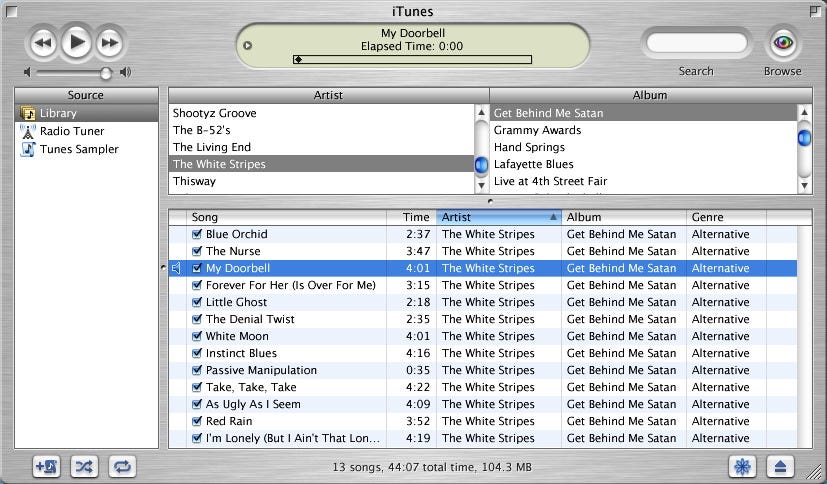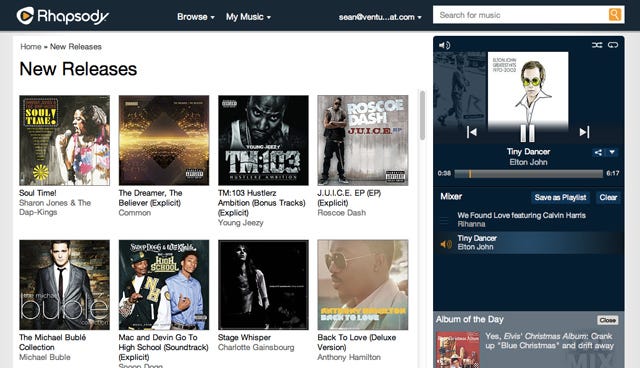It All Started with iTunes
I was an early adopter of digital music. I remember eagerly ripping my 300+ CD collection to my computer as soon as I got my first Mac back in 2001. By 2002 I had an iPod and almost never directly listened to CDs again. I was still buying them, but they would be immediately ripped and then I’d only listen to them as MP3s.
Those initial rips were only 128kbs MP3 files as that it what iTunes did back then, so over the years I did eventually re-rip my collection to eventually get it up to 256kbp AAC, which is as close to CD-quality as I really need.
At some point in the 2000s, I also stopped buying CDs altogether as it was easier (and cheaper) to just purchase the album from the iTunes Store. Back then iTunes let you listen to 30 second previews of album songs and sometimes even made an entire song available for free to download.
Both of those were great ways to easily tell if you might like the album before buying it.
The Dawn of Streaming
Also in the 2000s some streaming services started appearing. The first one I remember using was Rhapsody. Rhapsody was designed to let you stream on your computer. Back then you could not use streaming services on any portable devices (besides a laptop), so they were less practical. The price was enticing at just $5 a month, but the selection was not great. They had a somewhat limited selection of artists. But one other feature they had was that your $5 a month also got you five free MP3 downloads.
Since downloads were $1 each on iTunes, that meant that Rhapsody paid for itself as a way to try out new music and then get downloads for some songs I really liked. The downloads could be added to iTunes and played on my iPod.
I used Rhapsody for several years and by 2011 I was all in on digital music and had not bought a CD in years. Around that time I started hearing about a new streaming service called Spotify that had started in Europe was going to be coming to the US. It had a big library and was designed to work great with iPhones, both of which were appealing to me.
Streaming Hits the Big Time
When Spotify launched in the US later in 2011, I did give it a try, but I really did not like the app or its user interface. However, I absolutely loved the idea of a streaming app with the ability to easily play all music from my iPhone for just a small monthly fee.
I eventually found out about Rdio and after trying that decided it was perfect for me and signed up. I really like Rdio, which I think had the best music streaming UI, even to this day1. The only downside with Rdio is that its library was not as big as Spotify so there would be the occasional band missing. I particularly recall being annoyed at the time that Pretty Maids was not on Rdio.
By 2015 it was becoming obvious that Rdio was not doing well and was soon going to disappear. Apple Music had been announced in the summer of 2015, which certainly didn’t help Rdio’s situation. By fall I had to decide what my replacement would be, so I again tried Spotify and started trials for Apple Music, Google Music and Amazon Music. Ironically I did not give Rhapsody, which I think had now been renamed as Napster, a try.
Spotify was eliminated first. I still did not like its desktop or mobile apps, nor did I like its focus on playlists rather than on albums. I haven’t looked at it since.
Google Music was not bad and I liked that it let you upload your own music for streaming. This was important to me because in 2015, very little of Def Leppard’s music was available on any streaming service due to a licensing disagreement they had with their label. I of course had all their albums, so being able to upload them meant I could integrate their songs into playlists and such.
Amazon Music was nothing special so I didn’t seriously consider it.
Choosing Apple Music
In the end I of course went with Apple Music. After all, I was already an Apple guy and had an extensive iTunes library. Plus, Apple Music let you upload your own music, like Google Music, so I could get my precious Def Leppard albums. However, it was not smooth sailing in those early days. I recall that the first time I switched on Apple Music, it totally messed up my library. I don’t remember exactly what went wrong, but I remember I had to restore things from a Time Machine backup to get all my music back.
Apple Music is not perfect, but it does have high-quality AAC music that sounds great via bluetooth, which is the primary way I listen to music these days. Plus, they offer lossless music if you’re into that. There is also the Spatial Audio / Atmos audio versions of many albums, which brings a surround sound-like experience to music, although I find it usually doesn’t sound great with hard rock or metal.
One annoyance with Apple Music is that if you remove an album from your library, it also removes any songs on it from your playlists. That seems silly since you can absolutely add songs to playlists from albums not in your library. Why would I do this? Because sometimes a newer “Deluxe” version of an album comes out and I may not want both versions cluttering my library. Also, sometimes Apple Music just gets confused about an album and the only fix is to remove it from and re-add it to your library, which messes with playlists.
Since I switched to Apple Music in 2015, I’ve been creating “season playlists”, which consist of new stuff I am listening to at the time. In a future post, I’ll write more about them and highlight a few.
Downsides of Streaming
With all that said, there are downsides to streaming. From a consumer standpoint, if you are not listening to a lot of new music or a wide variety of music then you might be better off just buying the few albums you want and listening to them instead of paying $10+ a month for streaming.
Worse, the artists are getting totally screwed by music streaming. It’s essentially a deal with the devil for them as they have no choice to participate, but the royalties they get paid for streams is miniscule.
Whereas artists could live off albums sales in the 70s and 80s, today artists barely make any money from streaming and have to rely on tours, merch and direct music sales to make money.
Be sure to subscribe to get more great music content, including recaps of the seasonal playlists!
I still miss Rdio.






" Whereas artists could live off albums sales in the 70s and 80s"
...this sentiment gets repeated a lot, but what is never included: you could basically live off busking back then. The average artist loft here in NYC is probably out of range for even semi-popular bands back in the 70s. McKibben lofts here in Brooklyn are like $5,000/mo (more than doubled since I lived there in the early 00s) You can't really compare any career back in the 1970s to 2025.
That said, nice to finally see someone here say something other than "Streaming bad, vinyl good".
Interesting history. I don't even remember rhapsody. I dislike spotify because 1) I don't like some bot vacuuming up my data and 2) it keeps recommending shit, which makes me wonder about the algorithm! I still cling to my old vinyl collection even though I don't even have a working turntable....I guess I need to fix that!